UTA updates Planetarium in advance of once-in-a-lifetime eclipse

A recent technology upgrade has launched The University of Texas at Arlington Planetarium into truly rarified space.
The Planetarium—which features a 60-foot dome projection surface and provides educational entertainment to nearly 50,000 visitors each year—is now equipped with a Digistar 7 projection system, the most advanced technology commercially available to planetariums.
Digistar 7 uses six laser projectors for 360-degree ultra-bright high-resolution views. It features 3D models and provides universities and planetariums worldwide with instant real-time access to an extensive cloud of astronomy and science databases from the National Aeronautics and Space Administration and the National Oceanic and Atmospheric Administration, including the latest planetarium shows.
“The Digistar 7 system has better rendering capabilities and more detailed images,” said Levent Gurdemir, Planetarium director. “It’s a major leap forward from the Digistar 6 system that we previously used in the Planetarium. It allows us to travel through the universe and make extremely detailed explorations of the planets.”
The new system was made possible through a $50,000 donation from Arlington’s Women Inspiring Philanthropy. The gift was matched through the University of Texas System’s Library, Equipment, Repair and Rehabilitation Budget. The installation was completed in collaboration with UTA’s Office of Information Technology, the Office of Facilities Management, and students from the Computer Science and Engineering Department.
In addition, some hardware pieces were 3D printed at the Central Library’s FabLab. Students in a senior design class developed software to aid the projection geometry.
The grant also allowed the Planetarium to purchase two new planetarium shows, both specifically selected to support area school districts, as the show curriculum exceeds the Texas Education and Knowledge Standards (TEKS).
In addition to the upgrades at the main planetarium, UTA’s Observatory on the northeast side of campus has just completed the interior of its teaching and outreach facility. Located on top of the Park Central Garage, the observatory provides views of the moon, solar system, and deep-space objects. Its unique location allows for hosting large night classes and public star parties. The UTA Observatory is the only facility in the Dallas-Fort Worth area that offers public viewing programs.
The Observatory’s motorized dome structure features a fully automated 16-inch LX200GPS Meade Schmidt-Cassegrain telescope, as well as optical filters, an auto guiding system, a weather station and an astronomical-grade camera, which creates a direct video feed to UTA’s Planetarium. In addition to Planetarium use, the Observatory is utilized by astronomy and astrophysics classes and labs.
The Planetarium has hosted several public events at the Observatory, with more planned in the coming months. Of particular interest is thetotal solar eclipse on April 8, 2024. Passing over Mexico, the United States, and Canada, the path of the “totality” (when the moon completely blocks out the sun) will travel directly across North Texas, making the Dallas-Fort Worth area the largest metro area in the nation to see this once-in-a-lifetime event, which only happens about every 400 years. The partial eclipse will start at 12:23 p.m. and end at 3:02 p.m., with the totality starting at 1:40 p.m. and ending at 1:44 p.m.
“UT Arlington’s location in the middle of the Metroplex is perfect for viewing this rare solar eclipse,” Gurdemir said. “The Park Central Observatory will be a great place to watch the event on April 8.
“Between the rare ‘Ring of Fire’ eclipse in October and the upcoming total eclipse this spring, we have seen a spike in students and community members interested in learning about the solar system. All these upgrades to our facilities help enhance our ability to teach the importance of learning more about the world around us.”